The 64 Core Threadripper 3990X CPU Review: In The Midst Of Chaos, AMD Seeks Opportunity
by Dr. Ian Cutress & Gavin Bonshor on February 7, 2020 9:00 AM ESTAMD 3990X Against $20k Enterprise CPUs
For those looking at a server replacement CPU, AMD’s big discussion point here is that in order to get 64 cores on Intel hardware is relatively hard. The best way to get there is with a dual socket system, featuring two of its 28-core dies at a hefty $10k a piece. AMD’s argument is that users can consolidate down to a single socket, but also have better memory support, PCIe 4.0, and no cross-memory domain issues.
| AMD 3990X Enterprise Competition | |||
| AnandTech | AMD 3990X |
AMD 7702P |
Intel 2x8280 |
| SEP | $3990 | $4450 | $20018 |
| Cores/Threads | 64 / 128 | 64 / 128 | 56 / 112 |
| Base Frequency | 2900 | 2000 | 2700 |
| Turbo Frequency | 4300 | 3350 | 4000 |
| PCIe | 4.0 x64 | 4.0 x128 | 3.0 x96 |
| DDR4 Frequency | 4x 3200 | 8x 3200 | 12x 2933 |
| Max DDR4 Capacity | 512 GB | 2 TB | 3 TB |
| TDP | 280 W | 200 W | 410 W |
Unfortunately I was unable to get ahold of our Rome CPUs from Johan in time for this review, however I do have data from several dual Intel Xeon setups that I did a few months ago, including the $20k system.
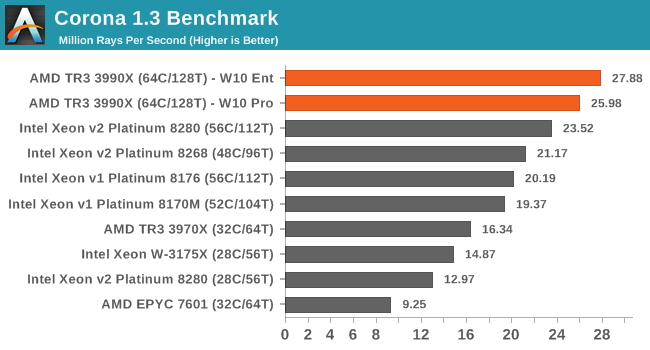
This time with Corona the competition is hot on the heels of AMD's 64-core CPUs, but even $20k of hardware can't match it.
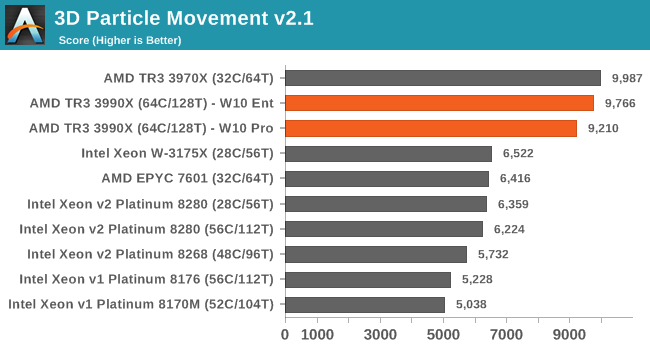
The non-AVX verson of 3DPM puts the Zen 2 hardware out front, with everything else waiting in the wings.
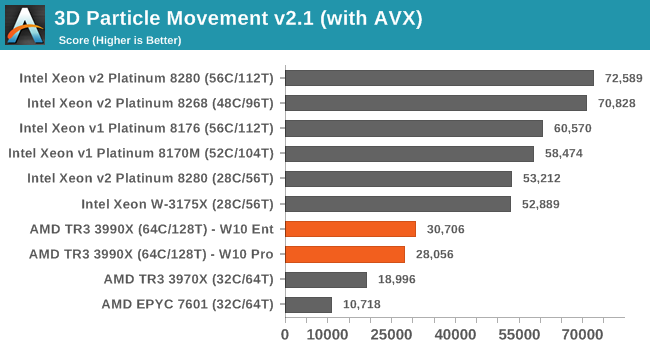
When we add in the AVX-512 hand tuned code, the situation flips: Intel's 56 cores get almost 2.5x the score of AMD, despite having fewer cores.
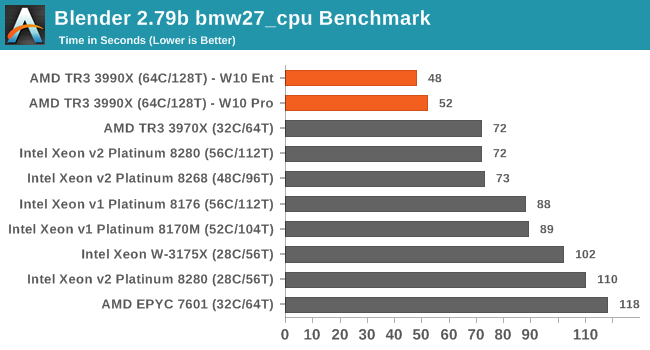
Blender doesn't seem to like the additional access latency from the 2P systems.
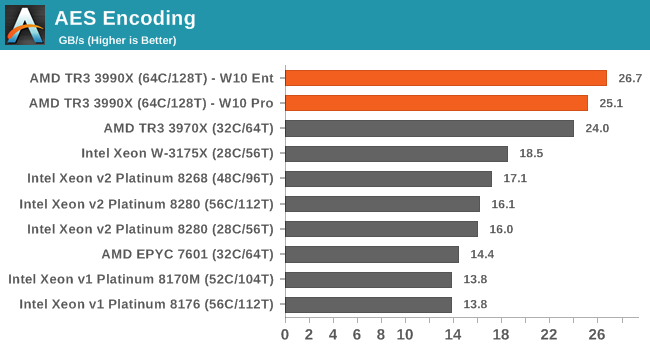
For AES encoding, as the benchmark takes places from memory, it appears that none of Intel's CPUs can match AMD here.
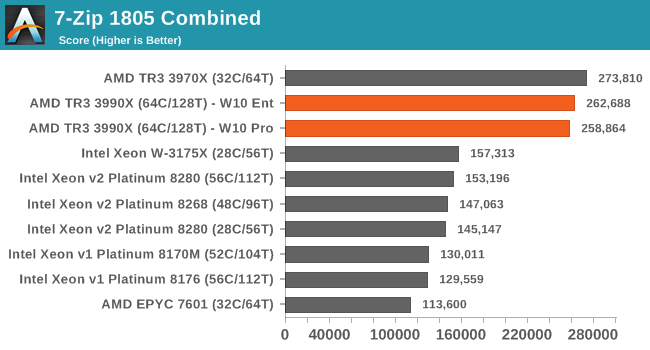
For the 7-zip combined test, there's little difference between AMD's 32-core and 64-core, but there are sizable jumps above Intel hardware.
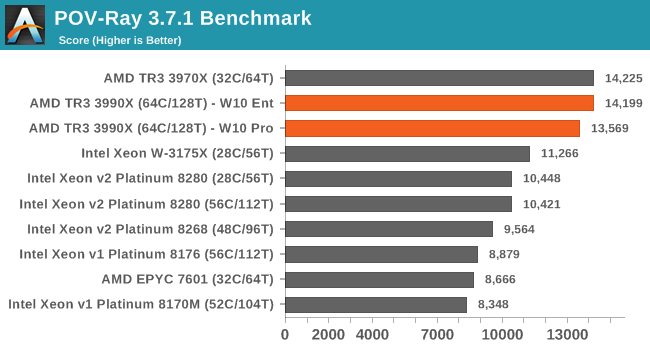

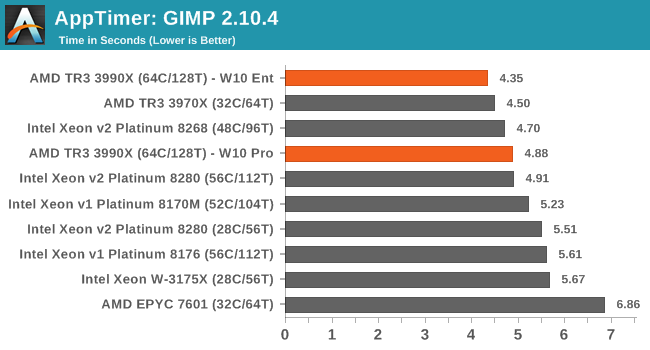
Verdict
In our tests here (more in our benchmark database), AMD's 3990X would get the crown over Intel's dual socket offerings. The only thing really keeping me back from giving it is the same reason there was hesitation on the previous page: it doesn't do enough to differentiate itself from AMD's own 32-core CPU. Where AMD does win is in that 'money is less of an issue scenario', where using a single socket 64 core CPU can help consolidate systems, save power, and save money. Intel's CPUs have a TDP of 205W each (more if you decide to use the turbo, which we did here), which totals 410W, while AMD maxed out at 280W in our tests. Technically Intel's 2P has access to more PCIe lanes, but AMD's PCIe lanes are PCIe 4.0, not PCIe 3.0, and with the right switch can power many more than Intel (if you're saving 16k, then a switch is peanuts).
We acknowledge that our tests here aren't in any way a comprehensive test of server level workloads, but for the user base that AMD is aiming for, we'd take the 64 core (or even the 32 core) in most circumstances over two Intel 28 core CPUs, and spend the extra money on memory, storage, or a couple of big fat GPUs.










279 Comments
View All Comments
PeachNCream - Monday, February 10, 2020 - link
Computer viruses predate Lotus 1-2-3.FunBunny2 - Tuesday, February 11, 2020 - link
the point is: 1-2-3 brought the effort mainstream, by showing how DOS was just a sieve to the hardware. recall that the PC with DOS was only one of three OS available, and PC sales didn't matter much until Corporate figured out that they just had to have 1-2-3. Mitch made Bill rich, not Bill. until 1-2-3, M$ was a legit systems software maker. after that, not so much. Xenix was they're OS of the future.FunBunny2 - Tuesday, February 11, 2020 - link
... and, for the PC, not according to this history: https://content.sentrian.com.au/blog/a-short-histo..."The first computer virus for MS-DOS was “Brain” and was released in 1986. It would overwrite the boot sector on the floppy disk and prevent the computer from booting. It was written by two brothers from Pakistan and was originally designed as a copy protection."
learned how to do that from 1-2-3
Khenglish - Friday, February 7, 2020 - link
Here's Unigine Heaven software rendered:https://i.imgur.com/0dfV4pd.png
https://i.imgur.com/CEWhX31.png
Fun fact: turning on tessellation drops fps by a factor of about 20.
Spunjji - Monday, February 10, 2020 - link
Holy cow, I had no idea.I'd be interested (as a purely theoretical exercise) to see where the ideal performance balance of cores / clock speed / memory bandwidth falls when it comes to software rendering.
GreenReaper - Saturday, February 8, 2020 - link
They use DirectX on Windows, and then Microsoft provides the fallback renderer.Mikewind Dale - Friday, February 7, 2020 - link
That might actually be an interesting test for someone who wants to run legacy games that don't support newer versions of Windows, DirectX, and/or don't have graphics driver support.For example, I was trying to play the original Diablo before the GoG version came out. It didn't work on my Radeon RX580, so I had to set up a VMWare Workstation virtual machine, with 3D acceleration support. However, even though VMWare Workstation supports 3D acceleration, it's still using my CPU, not my GPU. It's just that the virtual OS has software DirectX acceleration.
Anyway, I benchmarked 3DMark2001 SE running in a Window XP virtual machine on my 8-core Ryzen 7 2700X. I actually got scores that were competitive with GPUs from the early 2000s. So my software 3D acceleration on a Ryzen 7 2700X was approximately the same speed as a GPU from circa 2001.
It would be interesting to see how well a 64 core processor does.
Khenglish - Friday, February 7, 2020 - link
I get 5947 with a 3920xm (full 4c/8t ivb with 8MB cache) at 4.3 GHz. I would expect your 2700x to be a bit more than double that.https://i.imgur.com/aeQcFuu.png
Mikewind Dale - Saturday, February 8, 2020 - link
I'm getting about 6800. So perhaps the VMWare Workstation software display device cannot fully take advantage of parallelization?Spunjji - Monday, February 10, 2020 - link
That or it's not as efficient as Microsoft's software layer at translating DirectX code into something that can run on the CPU. If you had the time, you could try running 3DMark 2001 natively on your system the way Khenglish is and see if there's a difference.